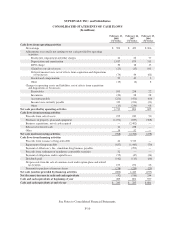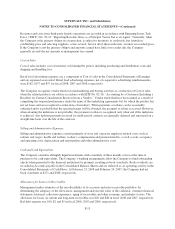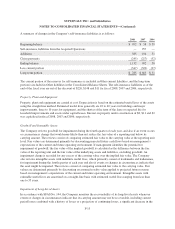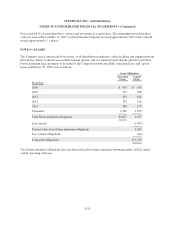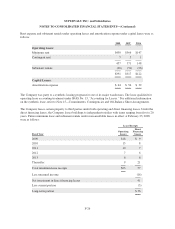Albertsons 2008 Annual Report Download - page 82
Download and view the complete annual report
Please find page 82 of the 2008 Albertsons annual report below. You can navigate through the pages in the report by either clicking on the pages listed below, or by using the keyword search tool below to find specific information within the annual report.SUPERVALU INC. and Subsidiaries
NOTES TO CONSOLIDATED FINANCIAL STATEMENTS—(Continued)
market value of an asset or the Company’s plans for store closures. When such events or changes in
circumstances occur, a recoverability test is performed by comparing projected undiscounted future cash flows to
the carrying value of the asset or group of assets as defined in SFAS No. 144. If impairment is identified for
long-lived assets to be held and used, the discounted future cash flows are compared to the asset’s current
carrying value and an impairment is recorded for the excess of the carrying value over the discounted future cash
flows. For long-lived assets that are classified as assets held for sale, the Company recognizes impairment
charges for the excess of the carrying value plus estimated costs of disposal over the estimated fair value.
Impairment charges are a component of Selling and administrative expenses in the Consolidated Statements of
Earnings.
Deferred Rent
The Company recognizes rent holidays, including the time period during which the Company has access to the
property prior to the opening of the site, as well as construction allowances and escalating rent provisions, on a
straight-line basis over the term of the lease. The deferred rents are included in Other current liabilities and Other
long-term liabilities in the Consolidated Balance Sheets.
Benefit Plans
Effective for fiscal 2007, the Company adopted SFAS No. 158, “Employers’ Accounting for Defined Benefit
Pension and Other Postretirement Plans—an amendment of FASB Statements No. 87, 88, 106 and 132(R),”
except for the measurement date provision which was adopted as of February 25, 2007. SFAS No. 158 requires
recognition of the funded status of the Company’s sponsored defined benefit plans in its Consolidated Balance
Sheets and gains or losses and prior service costs or credits as a component of other comprehensive income, net
of tax. The Company sponsors pension and other postretirement plans in various forms covering substantially all
employees who meet eligibility requirements. The determination of the Company’s obligation and related
expense for Company-sponsored pension and other postretirement benefits is dependent, in part, on
management’s selection of certain assumptions in calculating these amounts. These assumptions include, among
other things, the discount rate, the expected long-term rate of return on plan assets and the rates of increase in
compensation and health care costs.
Derivatives
The Company accounts for derivatives pursuant to SFAS No. 133, “Accounting for Derivatives and Hedging
Activities,” and SFAS No. 138, “Accounting for Certain Derivative Instruments and Certain Hedging Activity,
an Amendment of SFAS No. 133.” SFAS No. 133 and SFAS No. 138 require that all derivative financial
instruments are recorded on the balance sheet at their respective fair value.
The Company’s limited involvement with derivatives is primarily to manage its exposure to changes in interest
rates and foreign exchange rates. The Company uses derivatives only to manage well-defined risks. The
Company does not use financial instruments or derivatives for any trading or other speculative purposes.
Stock-based Compensation
Effective February 26, 2006, the Company adopted the provisions of SFAS No. 123 (revised 2004), “Share-
Based Payment” (“SFAS No. 123(R)”) using the modified-prospective transition method. The Company uses the
straight-line method to recognize compensation expense based on the fair value on the date of grant, net of the
estimated forfeiture rate, over the requisite service period related to each award. The fair value is estimated using
F-16






